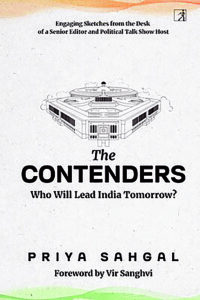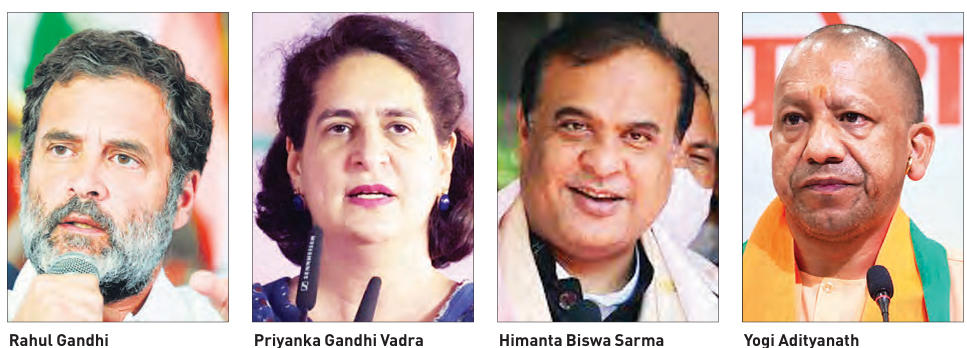NEW DELHI: Priya Sahgal’s book, ‘The Contenders’, has 14 engaging portraits of political leaders whom she suggests have a strong case in the coming years.
An implicit faith in the power of democracy animates India. Free and fair elections have been the cornerstone of the world’s oldest, largest and most vibrant democracy, helping erect a political edifice that contains a dynamic equilibrium of our diverse and pluralistic society. We are once again in the midst of conversations around aspirational political leaders from different parties during the ongoing 2024 general elections in which more than 50 crore people have already exercised their choice. Whether it is a leisurely chat between people at tea stalls, or a fiery exchange between a passenger and a driver, there seems to be no escape from the invariable turn towards the question, “who will be next?”, as in after 2029 and beyond because of the widely held belief that the Narendra Modi-led NDA will win handsomely in 2024.
Priya Sahgal’s book, “The Contenders”, attempts to answer this question through 14 engaging portraits of political leaders whom she suggests have a strong case in the coming years. As in many other things, leadership and charisma possess an outsized influence. The strength of an ideology or conviction rests on the shoulders of the political leader who espouses it. According to Sahgal, Rahul Gandhi, Akhilesh Yadav, Yogi Adityanath, Himanta Biswa Sarma, Sachin Pilot, Arvind Kejriwal, Anurag Thakur, Jyotiraditya Scindia, Milind Deora, Chaudhary Jayant Singh, Omar Abdullah, Asaduddin Owaisi, Tejashwi Yadav, and Priyanka Gandhi Vadra are the “contenders”.
Sahgal examines the prospects of these leaders against the backdrop of the political landscape dominated by Prime Minister Modi. The Prime Minister is absent by design but conspicuous in his absence. At 73 years old, he does not qualify as a “young” politician, even though one suspects he is the most energetic and youthful of all political leaders—young or old—in the fray. Even in his absence, the Prime Minister looms large over everyone else. As the definitive political leader of his age—perhaps, the defining leader of his time, he has single-handedly changed the grammar of governance in this country and ambition of a New India. His abundant influence on the national discourse permeates even Sahgal’s opinions of these 14 political leaders.
There is a subliminal “one vs all” narrative which countervails the author’s exploration of how this “next generation” will fare in the political arena that has been fundamentally reshaped by Narendra Modi. Will these leaders have the capability to build on the advantageous position that India has been brought to in the last ten years, or will they squander the potential?

Sahgal does an excellent job of examining the political arc of these politicians, and the capital of influence and goodwill they have generated. Some are national stalwarts, others are still regional heavyweights. Some are part of the ruling BJP, others align with the Opposition. Some are dynasts, others are self-made men—and I say “men” because there is only one woman on this list. As an advocate for equal voice, participation and leadership in politics and governance, and in a year when we celebrate the Modi-led passage of the Nari Shakri Adhiniyam providing for 33% reservation for women in Parliament and State Assemblies after 27 years of procrastination, I found that quite disappointing.
Priya, herself a staunch feminist who runs a wonderful show titled “We Women Want”, is unhappy about that. More women leaders need to claim their rightful place in the narrative of women-led development that PM Modi has sedulously nurtured and now consecrated globally through India’s G20 Presidency, vowing to enhance women’s full, effective, equal and meaningful participation as decision-makers in all spheres of society, across all sectors, and at all levels of the economy and polity. It is my hope that the Women’s Reservation Bill is the lever that opens the floodgates, and compels Sahgal to add a few more women in her 2029 update.
Nevertheless, Sahgal provides an arresting assessment of Priyanka Gandhi Vadra’s political career, and her curious sidelining by the Congress despite abundant oratorical abilities and political charm. The account of how Priyanka Gandhi came to peace with the assassins of her father is tenderly described, and indeed, quite moving. While Priyanka Gandhi’s mixed record in politics and negotiating with alliance partners are highlighted, Sahgal credits her with being the more “instinctive” politician in the family. There is a hint about how family and children could have been a constraint for Priyanka herself being a reluctant helmswoman in the Congress Party. The author leaves us with the mischievous suggestion that Priyanka’s career is as yet undefined in order to prop up Rahul Gandhi, whom she describes as a “perpetual work in progress” and “political yatri”.
Not fielding Priyanka Gandhi Vadra in Rae Bareli, but instead according to Rahul Gandhi another soft landing, bears out her analysis of the confusing machinations of the Congress. Her chapter on Rahul Gandhi is the most insightful—at once empathetic and critical. She labels him “an inconsistent leader”, not suited for the “cut and thrust of politics”. The author pokes fun at Rahul Gandhi’s tendency to compensate for his rich and elitist upbringing by mentioning that an unstated joke in Congress during Rahul’s first decade in politics was that the “more jholawala and dishevelled your appearance, the more chances you had of striking a chord with the Congress heir. Often Youth Congress leaders used to take off their Rolex watches and park their cars at a nearby five-star and take an auto to a meeting with Rahul.” She continues with another powerful observation, “he has to get his own party to have faith in him, before he can get the rest of India to vote for him.” It was Sahgal who had said in 2007 that “while his grandfather may have written The Discovery of India, the grandson today has embarked on his own version of Discovery tourism.” This observation seems to hold true even today. Rahul Gandhi continues to wander and discover India even as it moves past him.
Written with characteristic wit and page-turning flair, Sahgal portrays the political journey of these leaders from the vantage point of an amiable but fair journalist. Even as she unsparingly scrutinises the actions and public utterances of these leaders, she still offers a rare balance. This distinction of balance must not be confused with neutrality, however; neither does she seek it in her writing, nor is it desirable in such a compilation. Sahgal clearly has her favourites and those whom she doesn’t like. Much of it is shaped by her political leanings, interactions, and interviews. The reader will learn much from those sections, and perhaps also acknowledge the expert eye of a political journalist. This book simmers with a genial warmth because it combines objectivity with popular perception.
Sahgal peeps behind the psyche of these leaders and draws on her numerous interactions and press tours with them to derive some insights about their character and motivations. Her analysis of the political compulsions of leaders such as Himanta Biswa Sarma and Jyotiraditya Scindia—both of whom crossed over from the Congress to BJP—provide a captivating inside view into the myriad elements of Indian politics. She presents an intriguing narrative of Akhilesh Yadav and the Samajwadi Party’s recent trials and tribulations as he tries to “preserve the party’s legacy.” Sahgal has included two Muslim leaders, Asaduddin Owaisi and Omar Abdullah, on her list, deftly capturing the anxieties and preoccupations of the two most prominent Muslim leaders. She questions Owaisi’s penchant for wading into every controversy with communal overtones and for polarising narratives, but is also quite clearly fascinated by his audacity and “biryani and Haleem diplomacy”.
Sahgal’s views on Kejriwal are overtaken by the subsequent implosion in and of the Aam Aadmi Party, and the erosion—if not demolition—of his anti-corruption, aam aadmi, and woman-respecting persona. I strongly disagreed with the author’s characterisation of Yogi Adityanath as a “rabble-rouser” and his administration’s tough stance on law-and-order issues, even though she does admit to his representing a spiritual political model of leadership that PM Modi espouses and to his turning more statesmanlike in his second term. Her judgement belies the tremendous achievements made in a state that was notorious for its crime and poverty once upon a time, and is now racing towards a $1 trillion economy. Regardless of her bias, I found that I was never bored or put off. The hallmark of a good writer!
The categories under which Sahgal presents the portraits of these political leaders offer some insight into the enigma and complexities of the Indian political system. That the system is filled with its fair share of dynasts is something Sahgal points to, and wonders if the recent emphasis on merit over dynasty is increasingly penetrating the voters’ psyche. If national leaders like Rahul fail because he may have “a pan-India image but not a pan-India impact”, would the regional satraps assume a national mantle is another question she explores. Sahgal touches upon the privilege and pressure of a political legacy, as she evaluates how well India’s dynasty-driven political system is faring while throwing up leaders from the grassroots like PM Modi himself.
A breezy compilation such as this necessitates that the writing is done with a light touch that prioritises personal experiences over academic detail. Within that remit, I was pleasantly surprised to find that Sahgal was able to imbue her commentary with scholarly attention. Viewed together, they provide an excellent snapshot of the mainstream political leadership spectrum. Over the years, her prolific writing on the political affairs of the country have won many admirers. This book is an engrossing intervention as it allows us to interrogate and learn about the political leaders who might steward and champion India in the next decades.
“The Contenders” is a flavourful exploration of some of the most prominent leaders in Indian politics today. Distinguished by her flair and poise, Sahgal invites the reader to enjoy the nuance behind our political conversations. In the throes of the ongoing eighteenth Lok Sabha elections—this latest iteration of the grand Indian democratic experiment—it is bound to stoke the interests of many people, particularly the youth, in learning more about the journeys of the younger among our aspirational leaders.
Lakshmi Puri is a former Assistant Secretary-General of the United Nations and Deputy Executive Director of UN Women; and a former Ambassador of India.

